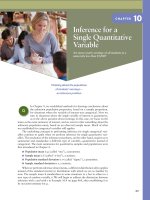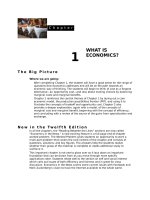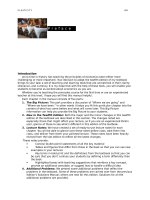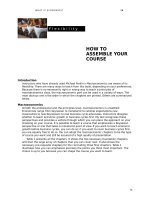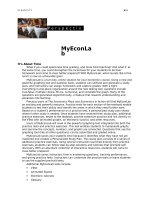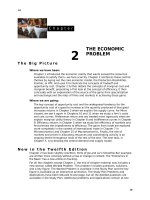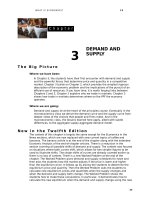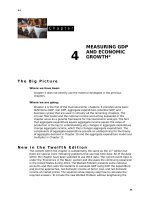The big picture marcoeconomics 12e parkin chapter 03
Bạn đang xem bản rút gọn của tài liệu. Xem và tải ngay bản đầy đủ của tài liệu tại đây (491.29 KB, 17 trang )
W H AT I S E C O N O M I C S ?
23
C h a p t e r
3
DEMAND AND
SUPPLY
The Big Picture
Where we have been:
In Chapter 3, the students have their first encounter with demand and supply
and the powerful forces that determine price and quantity in a competitive
market. Chapter 3 builds on Chapter 2, which provides the simplest rigorous
description of the economic problem and the implications of the pursuit of an
efficient use of resources. If you have time, it is worth forging links between
Chapters 2 and 3. Chapter 2 explains why we trade in markets. Chapter 3
shows how trade in markets determines where on the PPF the economy
operates.
Where we are going:
Demand and supply lie at the heart of the principles course. Eventually in the
microeconomics class we derive the demand curve and the supply curve from
deeper views of the choices that people and firms make. And in the
macroeconomic class, the lessons learned here apply, albeit with subtle
differences, to the aggregate supply-aggregate demand model.
N e w i n t h e Tw e l f t h E d i t i o n
The content of this chapter is largely the same except for the Economics in the
News sections, which are now replaced with new current topics of coffee and
bananas. The banana article is at the end of the chapter along with the extended
Economic Analysis of the end-of-chapter articles. There is a reduction in the
section covering all possible shifts of demand and supply. The content now focuses
on situations where both curves shift, which allows for two simpler figures to be
used to illustrate shifts. The single shifts of curves are already covered earlier so
there is no loss of content. There is a new Worked Problem at the end of the
chapter. The Worked Problem gives demand and supply schedules for roses and
then asks the students how the market adjusts if the price is lower and higher
than the equilibrium price. It follows up by asking the students to determine the
equilibrium price and quantity. Then the Worked Problem asks the students to
calculate new equilibrium prices and quantities when the supply changes and
when the demand and supply both change. The Worked Problem shows the
students how to make these calculations. In particular, it demonstrates how to
calculate the new equilibrium when the demand and supply change using the new
23
24
demand and supply schedules and using a supply and demand diagram. To
include the new Worked Problem without lengthening the chapter, some problems
have been removed from the Study Plan Problem and Applications. These
problems are in the MyEconLab and are called Extra Problems.
24
Lecture Notes
Demand and Supply
In our market-based economy, the interaction of demand and supply in markets
determines the prices of goods and services and the quantity produced and
consumed.
Changes in demand and/or supply lead to changes in the price of the good or service
and in the quantity produced and consumed.
Markets vary in the intensity of competition. This chapter studies a competitive
market, which is a market that has many buyers and sellers, so no single buyer or
seller can influence price.
The money price of a good or service is the number of dollars that must be given
up for it. The ratio of one (money) price to another is called a relative price. A
relative price is an opportunity cost. The theory of demand and supply determines
relative prices and so when we use the word “price” we mean “relative price.”
To point out the importance of relative prices, ask your students if turkey at 40¢ a pound is
a good buy. Tell them that is all they know—turkey is 40¢ a pound. Generally most students
respond that turkey at this price is cheap and a good buy. Then tell them that steak is 8¢ a
pound. Now is turkey such a good buy? Students realize that the relative price of turkey is
5 pounds of steak per pound of turkey and so turkey is actually expensive. Point out to
them that these money prices are actual prices from circa 1800. At that time, turkey was
relatively quite expensive because turkeys could fly and needed to be hunted rather than
harvested! Also point out to them the unimportance of the money price and the crucial
importance of the relative price.
I.
Demand
The price of a good or service affects the quantity people plan to buy. The quantity
demanded of a good or service is the amount that consumers plan to buy during a
given time period at a particular price.
The law of demand states that other things remaining the same, the higher the
price of a good, the smaller is the quantity demanded; and the lower the price of a
good, the greater the quantity demanded. The law of demand occurs for two
reasons:
Substitution Effect: When the relative price of good changes, the opportunity cost
of the good changes. An increase in the price increases the opportunity cost of
buying the good and people respond by buying less of the good and buying more
of its substitutes.
Income Effect: A change the price of a good changes the amount that a person
can afford to buy. When the price of a good rises, people cannot afford to buy the
same quantities that they purchased before, so the quantities bought of some
goods and services must decrease. Normally the good whose price rises is one of
the goods for which less is purchased.
Demand Curve and Demand Schedule
The demand for a
Price
Quantity
good refers to the
(dollar
demande
entire relationship
s per
d
between the price of
unit)
(units)
1
50
2
40
3
30
4
20
5
10
[Type text]
22
CHAPTER 3
the good and the quantity demanded of the good. The table gives a demand
schedule.
A demand curve shows the relationship between the quantity demanded of a good
and its price when all other influences on consumers’ planned purchases remain the
same. The figure illustrates the demand curve resulting from the demand schedule.
The demand curve is a willingness-to-pay curve—for each quantity, the price along
the demand curve is the highest price a consumer is willing to pay for that unit of
output which means that a demand curve is a marginal benefit curve.
Of the hundreds of classroom experiments that are available today, very few are worth the
time they take to conduct. The classic demand-revealing experiment is one of the most
productive and worthwhile ones. Bring to class two bottles of ice-cold, ready-to-drink Mt.
Dew, bottled water, or sports drink. (If your class is very large, bring six bottles). Tell the
students that you have these drinks and ask them to indicate if they would like one. Most
hands will go up. Tell the class that you are going to sell them to the high bidder. Tell them
that this auction is real. The winner will get the drink and will pay. Ask for a show of hands
of those who have some cash and can afford to buy a drink. Explain that these indicate an
ability to buy but not a definite plan to buy. Now begin the auction. Appoint a student to
count hands (more than one for a big class). Begin at a low price: say 10¢ a bottle and
count the number willing to buy. Raise the price in 10¢ increments and keep the tally of the
number who are willing to buy at each price. When the number willing to buy equals the
number of bottles you have for sale, do the transactions. (If you make a profit, and you
might do so, tell the students that the profit, small though it is, will go the department fund
for undergraduate activities—and deliver on that promise.) Now use the data to make a
demand curve for Mt. Dew (or other drink) in your classroom today. You can easily
emphasize the law of demand. And, now that you have a demand curve, you can do some
thought experiments that will shift it. Ask: How would this demand curve have been
different if the temperature in the classroom was 10 degrees higher/lower? How would this
demand curve have been different if half the class was sick and absent today? How would
this demand curve have been different if there was a Coke machine right in the classroom?
A Change in Demand (Demand Shifters)
When any factor that influences buying plans other than the price of the good
changes, there is a change in demand and the demand curve shifts. An increase in
demand shifts the demand curve rightward and a decrease in demand shifts the
demand curve leftward. Six factors change demand:
Prices of Related Goods: A substitute is a good that can be used in place of
another good (tea and coffee) and a complement is a good that is used in
conjunction with another good. (sugar and coffee). A rise in the price of a
substitute or a fall in the price of a complement increases the demand for the
good.
Expected Future Prices: If the price of a good is expected to rise in the future, the
demand for the good today increases.
Income: A normal good is one for which demand increases as income increases;
an inferior good is one for which demand decreases as income increases.
Expected Future Income and Credit: When
expected future income increases, demand
today increases. When credit becomes
easier to obtain, demand increases.
Population: The larger the (relevant)
population, the greater the demand.
D E M A N D A N D S U P P LY
Preferences: Preferences are an individual’s attitudes toward goods and services.
If people “like” a good more, the demand for it increases.
A Change in the Quantity Demanded Versus a Change in Demand
A change in price results in a movement along the demand curve, which is change
in the quantity demanded. A change in other factors shifts the demand curve,
which is a change in demand.
In the figure, the movement along demand curve D0 from point a to point b as a
result of the price rising from $2 to $4 is a change in the quantity demanded. The
shift of the demand curve from D0 to the new demand curve D1 is a change in
demand.
23
24
CHAPTER 3
II. Supply
The price of a good or service affects the quantity firms plan to sell. The quantity
supplied of a good or service is the amount that firms plan to sell during a given
time period at a particular price.
The law of supply states that other things remaining the same, the higher the
price of a good, the greater is the quantity supplied; and the lower the price of a
good, the smaller the quantity supplied. The law of supply occurs because an
increase in the quantity of a good produced results in an increase in its marginal
cost. So the price must rise in order to induce firms to increase the quantity they
produce.
Supply Curve and Supply Schedule
The supply of
a good
Price
Quantit
refers to the
entire
(dollar
y
relationship
s per
supplie
between the
price
unit)
d
of the good
and
(units)
the quantity
1
10
supplied of
the
2
20
good. The
table
3
30
gives a supply
4
40
schedule.
5
50
A supply
curve
shows the relationship between the quantity
supplied of a good and its price when all
other influences on producers’ planned sales
remain the same. The figure illustrates the
supply curve resulting from the supply
schedule.
The supply curve is a minimum-supply-price curve—for each quantity, the price
along the supply curve is the lowest price a producer must receive in order to
produce that unit of output which means that a supply curve is a marginal cost
curve.
A Change in Supply (Supply Shifters)
When any factor that influences selling plans other than the price of the good
changes, there is a change in supply and the supply curve shifts. An increase in
supply shifts the supply curve rightward and a decrease in supply shifts the supply
curve leftward. Six factors change supply:
Prices of Productive Resources: If the price of a resource used to produce the
good rises, the supply of the good decreases.
Prices of Related Goods Produced: A substitute in production is a good that can
be produced using the same resources and a complement in production is a good
that must be produced with the initial good. A fall in the price of a substitute in
production or a rise in the price of a complement in production increases the
supply of the good.
Expected Future Prices: If the price of a good is expected to rise in the future, the
supply of the good today decreases.
Number of Suppliers: If the number of suppliers increases, the supply increases.
Technology: Technology refers to the ways in which factors of production are used
to produce a good. A technological advance increases the supply of a good.
The State of Nature: The state of nature includes all natural forces that influence
supply. Bad weather or an earthquake decreases the supply of a good.
D E M A N D A N D S U P P LY
25
A Change in the Quantity Supplied Versus a
Change in Supply
A change in price results in a movement
along the supply curve, which is change
the quantity supplied. A change in
other factors shifts the supply curve,
which is a change in supply.
In the top figure, the movement along
supply curve S0 from point a to point b as
result of the price rising from $2 to $4 is
change in the quantity supplied. The shift
the supply curve from S0 to the new
supply curve S1 is a change in supply.
in
a
a
of
III. Market Equilibrium
An equilibrium is a situation in which
opposing forces balance.
The equilibrium price is the price at
which the quantity demanded equals the
quantity supplied. The equilibrium
quantity is the quantity bought and sold
the equilibrium price. In the figure, the
equilibrium price is $3 and the
equilibrium quantity is 30 per week.
at
Price as a Regulator and Price Adjustments
The price of a good regulates the
quantities demanded and supplied.
Shortage: If the price is below the
equilibrium price, consumers plan to buy
more than firms plan to sell. A shortage
results, which forces the price higher, toward the equilibrium price. In the figure,
there is a shortage at any price below $3 and so the price is forced higher, toward
the equilibrium price.
Surplus: If price is above the equilibrium, firms plan to sell more than consumers
plan to buy. A surplus results, which forces the price lower, toward the equilibrium
price. In the figure, there is a surplus at any price above $3 and so the price is forced
lower, toward the equilibrium price.
The price continues to adjust until the quantity supplied equals quantity demanded.
To help students have a base of knowledge from which build tell them to memorize “Home
Base”—the basic Supply and Demand curves showing an initial starting position with
proper labels on the axis’ and an initial equilibrium, P0 and Q0 on the axis at the
intersection of the two curves. “Home Base” provides them a starting place for every story
problem they face. Then as you work through examples, be sure to ask them what “shifter”
is changing. This procedure will keep them using the economic tool rather than just going
with a gut feeling.
The magic of market equilibrium and the forces that bring it about and keep the market
there need to be demonstrated with the basic diagram, with intuition, and, if you’ve already
used the demand experiment outlined above, with hard evidence in the form of the class
26
CHAPTER 3
activity. Using the experiment is straightforward. Start by explaining that in that market,
the supply was fixed (vertical supply curve) at the quantity of bottles that you brought to
class. The equilibrium occurred where the market demand curve (demand by the students)
intersected your supply curve. Point out that the trades you made in your little economy
made both buyers and sellers better off.
Back in the dim mists of time, circa 1870 or so, economists struggled to understand if it was
the supply or the demand that determined the price and quantity of a good. Nowadays we
know that these efforts were misguided. To borrow from the great economist Alfred
Marshall, demand and supply curves are like the blades on a pair of scissors. It does not
make sense to ask which blade does the cutting because the cutting takes both blades and
occurs at the intersection of the two blades. Likewise, it takes both the demand and supply
to determine the price and quantity and the price and quantity are determined at the
intersection of the demand and supply curves.
IV. Predicting Changes in Price and Quantity
The demand and supply model can be used to determine how changes in factors affect a
good’s price and quantity.
A Change In Demand
If the demand for a good or service
increases, the demand curve shifts
rightward. As a result, the equilibrium price
rises and the equilibrium quantity
increases.
If the demand for a good or service
decreases, the demand curve shifts
leftward. As a result, the equilibrium price
falls and the equilibrium quantity
decreases.
Supply does not change and the supply
curve does not shift. Instead there is a
change in the quantity supplied and a
movement along the supply curve.
The figure illustrates an increase in
demand. In the figure the demand curve shifts from D0 to D1. As a result, the
equilibrium price rises from $3 to $4 and the equilibrium quantity increases from 30
to 40. The supply curve does not shift; there is, however, a movement along the
supply curve.
An Economic in the News feature discusses the factors that have led to higher college
tuition. Because enrollment has also increased, the analysis concludes that increases in
demand are the factor that has created the higher tuition.
A Change In Supply
If the supply of a good or service
increases, the supply curve shifts
rightward. As a result, the equilibrium
price falls and the equilibrium quantity
increases.
If the supply of a good or service
decreases, the supply curve shifts
D E M A N D A N D S U P P LY
leftward. As a result, the equilibrium price rises and the equilibrium quantity
decreases.
Demand does not change and the demand curve does not shift. Instead there is a
change in the quantity demanded and a movement along the demand curve.
The figure illustrates an increase in supply. In the figure the supply curve shifts from
S0 to S1. As a result, the equilibrium price falls from $3 to $2 and the equilibrium
quantity increases from 30 to 40. The demand curve does not shift; there is,
however, a movement along the demand curve.
An Economic in the News explores the factors that led to a fall in the price of coffee. The
analysis concludes that a bumper crop of coffee lies behind the fall in price.
The whole chapter builds up to this section, which now brings all the elements of demand,
supply, and equilibrium together to make predictions. Students are remarkably ready to
guess the consequences of some event that changes either demand or supply or both. They
must be encouraged to work out the answer and draw the diagram. Explain that the way to
answer any question that seeks a prediction about the effects of some event(s) on a market
has five steps. Once you have already worked an example or two, walk them through the
steps and have one or two students work some examples in front of the class. The five steps
are:
1. Draw a demand-supply diagram and label the axes with the price and quantity of the
good or service in question.
2. Think about the event(s) that you are told occur and decide whether they change
demand, supply, or both demand and supply.
3. Determine if the events that change demand or supply bring an increase or a decrease.
4. Draw the new demand curve and supply curve on the diagram. Be sure to shift the
curve(s) in the correct direction—leftward for decrease and rightward for increase. (Lots
of students want to move the curves upward for increase and downward for decrease—
this view works ok for demand but is exactly wrong for supply. So emphasize the leftright shift.)
5. Find the new equilibrium and compare it with the original one.
It is critical at this stage to return to the distinction between a change in demand (supply)
and a change in the quantity demanded (supplied). You can now use these distinctions to
describe the effects of events that change market outcomes. At this point, the students
know enough for it to be worthwhile emphasizing the magic of the market’s ability to
coordinate plans and reallocate resources.
Demand and Supply Change in the Same Direction
If both the demand and the supply of a good or service increase, both the demand
and supply curves shift rightward. The quantity unambiguously increases but the
effect on the price is ambiguous.
If the increase in demand is greater than the increase in supply, the price rises.
If the increase in demand is the same size
as the increase in supply, the price does
not change.
If the increase in demand is less than the
increase in supply, the price falls.
If both the demand and the supply of a good
or service decrease, both the demand and
27
28
CHAPTER 3
supply curves shift leftward. The quantity unambiguously decreases but the effect
on the price is ambiguous.
If the decrease in demand is greater than the decrease in supply, the price falls.
If the decrease in demand is the same size as the decrease in supply, the price
does not change.
If the decrease in demand is less than the decrease in supply, the price rises.
The figure illustrates an increase in both demand and supply. In the figure the
demand curve shifts from D0 to D1 and the supply curve shifts from S0 to S1. The
shifts are the same size, so the equilibrium price does not change and the
equilibrium quantity increases from 30 to 50.
D E M A N D A N D S U P P LY
Demand and Supply Change in the Opposite Directions
If the demand increases and the supply
decreases, the demand curve shifts
rightward and the supply curve shifts
leftward. The price unambiguously rises
but the effect on the quantity is
ambiguous.
If the increase in demand is greater
than the decrease in supply, the
quantity increases.
If the increase in demand is the same
size as the decrease in supply, the
quantity does not change.
If the increase in demand is less than
the decrease in supply, the quantity
decreases.
If the demand decreases and the supply increases, the demand curve shifts leftward
and the supply curves shifts rightward. The price unambiguously falls but the effect
on the quantity is ambiguous.
If the decrease in demand is greater than the increase in supply, the quantity
decreases.
If the decrease in demand is the same size as the increase in supply, the
quantity does not change.
If the decrease in demand is less than the increase in supply, the quantity
increases.
The figure illustrates an increase in demand and a decrease in supply. In the figure
the demand curve shifts from D0 to D1 and the supply curve shifts from S0 to S1. The
shifts are the same size, so the equilibrium quantity does not change and the
equilibrium price rises from $3 to $5.
The Economic in the News explores the market for bananas. A disease that damages
banana crops has spread from Southeast Asia to the Middle East. The disease has
decreased the supply of bananas, resulting in the price rising and quantity decreasing.
29
30
CHAPTER 3
Additional Problems
1.
What is the effect on the price of hotdogs and the quantity of hotdogs sold if
a. The price of a hamburger rises?
b. The price of a hotdog bun rises?
c. The supply of hotdog sausages increases?
d. Consumers’ incomes increase if hot dogs are a normal good?
e. The wage rate of a hotdog seller increases?
f. If the wage rate of the hotdog seller rises and at the same time prices of
ketchup, mustard, and relish fall?
2.
Suppose that one of the following events occurs:
(i) The price of wool rises.
(ii) The price of sweaters falls.
(iii) A close substitute for wool is invented.
(iv) A new high-speed loom is invented.
a.
b.
c.
d.
3.
Which of the above events increases or decreases (state which)
The demand for wool?
The supply of wool?
The quantity of wool demanded?
The quantity of wool supplied?
Figure 3.1 illustrates the market for bread.
a. Label the curves in the figure.
b. What are the equilibrium price of bread
and the equilibrium quantity of bread?
D E M A N D A N D S U P P LY
4.
5.
6.
The demand and supply schedules
for potato chips are in the table.
a. What are the equilibrium price and
equilibrium quantity of potato
chips?
b. If chips were 60 cents a bag,
describe the situation in the
market for potato chips and
explain what would happen to the
price of a bag of chips.
Price
(cents per
bag)
40
50
60
70
80
90
100
110
Quantity
Quantity
demand
supplied
ed
(millions of bags a
week)
170
90
160
100
150
110
140
120
130
130
120
140
110
150
100
160
In problem 4, suppose a new snack
food comes onto the market and as
a
result the demand for potato chips
decreases by 40 million bags per
week.
a. Has there been a shift in or a movement along the supply curve of chips?
b. Has there been a shift in or a movement along the demand curve for chips?
c. What is the new equilibrium price and quantity of chips?
In problem 5, suppose that a flood destroys several potato farms and as a
result supply decreases by 20 million bags a week at the same time as the
new snack food comes onto the market. What is the new equilibrium price
and quantity of chips?
Solutions to Additional Problems
1. a. The price of a hot dog rises, and the quantity of hot dogs sold increases. Hot dogs
and hamburgers are substitutes. If the price of a hamburger rises, people buy more
hot dogs and fewer hamburgers. The demand for hot dogs increases. The price of a
hot dog rises, and more hot dogs are sold.
b. The price of a hot dog falls, and fewer hot dogs are sold. Hot dog buns and hot dogs
are complements. If the price of a hot dog bun rises, fewer hot dog buns are bought.
The demand for hot dogs decreases. The price of a hot dog falls, and people buy
fewer hot dogs.
c. The price of a hot dog falls and more hot dogs are sold. The increase in the supply of
hot dog sausages lowers the price of hot dog sausages. Hot dog sausages are a
factor used in the production of hot dogs. With the lower priced factor, the supply of
hot dogs increases. The price of a hot dog falls and people buy more hot dogs.
d. The price of a hot dog rises, and the quantity sold increases. An increase in
consumers' income increases the demand for hot dogs. As a result, the price of a hot
dog rises and the quantity bought increases.
e. The price of a hot dog rises, and the quantity sold decreases. If the wage of the hot
dog seller increases, the cost of producing a hot dog increases and the supply of hot
dogs decreases. The price rises, and people buy fewer hotdogs.
f. The price of a hot dog rises, but the quantity might increase, decrease, or remain the
same. Ketchup, mustard, and relish are complements of hot dogs. If the price of
ketchup, mustard, and relish fall, more ketchup, mustard, and relish are bought and
the demand for hot dogs increases. The price of a hot dog rises, and people buy
more hot dogs. If the wage of the hot dog seller increases, the cost of producing a
hot dog increases and the supply of hot dogs decreases. The price rises, and people
31
32
CHAPTER 3
buy fewer hotdogs. Taking the two events together, the price of a hot dog rises, but
the quantity might increase, decrease, or remain the same.
2. a. (ii) and (iii) Wool is used in the production of sweaters. If the price of a sweater falls
because the supply of sweaters has increased, then the equilibrium quantity of
sweaters increases and the demand for wool increases. If the price of a sweater falls
because the demand for sweaters has decreased, then the equilibrium quantity of
sweaters decreases and the demand for wool decreases. If a close substitute for wool
is invented, some sweater producers will switch from wool to the substitute. When
they do, the demand for wool decreases.
b. (iv) If a new high-speed loom is invented, the cost of making wool will fall and the
supply of wool will increase.
c. (i) and (iv) If the price of wool rises there is a movement up along the demand curve.
The quantity demanded of wool decreases. If a new high-speed loom is invented, the
cost of producing wool will fall. So the supply of wool increases. With no change in
the demand for wool, the price of wool will fall and there is a movement down along
the demand curve for wool. The quantity demanded of wool increases.
d. (i), (ii), and (iii) If the price of wool rises there is a movement up along the supply
curve. The quantity supplied of wool increases. If the price of a sweater falls because
the supply of sweaters has increased, then the equilibrium quantity of sweaters
increases and the demand for wool increases. With no change in the supply of wool,
the price of wool rises and the quantity of wool supplied increases. If the price of a
sweater falls because the demand for sweaters has decreased, then the equilibrium
quantity of sweaters decreases and the demand for wool decreases. With no change
in the supply of wool, the price of wool falls and the quantity of wool supplied
decreases. If some sweater producers switch to using the new close substitute for
wool, the demand for wool will decrease. With no change in the supply of wool, the
price of wool falls and the quantity of wool supplied decreases.
3. a. The demand curve is the curve that slopes down toward to the right. The supply
curve is the curve that slopes up toward to the right.
b. The equilibrium price is $3 a loaf, and the equilibrium quantity is 100 loaves a day.
Market equilibrium is determined at the intersection of the demand curve and supply
curve.
4. a. The equilibrium price is 80 cents a bag, and the equilibrium quantity is 130 million
bags a week. The price of a bag adjusts until the quantity demanded equals the
quantity supplied. At 80 cents a bag, the quantity demanded is 130 million bags a
week and the quantity supplied is 130 million bags a week.
b. At 60 cents a bag, there will be a shortage of potato chips and the price will rise. At
60 cents a bag, the quantity demanded is 150 million bags a week and the quantity
supplied is 110 million bags a week. There is a shortage of 40 million bags a week.
The price will rise until market equilibrium is restored—80 cents a bag.
5. a. There has been a movement along the supply curve. The demand for potato chips
decreases, and the demand curve shifts leftward. Supply does not change, so the
price falls along the supply curve.
b. The demand curve has shifted leftward. As the new snack food comes onto the
market, the demand for potato chips decreases. There is a new demand schedule,
and the demand curve shifts leftward.
c. The equilibrium price is 60 cents, and the equilibrium quantity is 110 million bags a
week. Demand decreases by 40 million bags a week. That is, the quantity demanded
at each price decreases by 40 million bags. The quantity demanded at 80 cents is
now 90 million bags, and there is a surplus of potato chips. The price falls to 60
D E M A N D A N D S U P P LY
cents a bag, at which the quantity supplied equals the quantity demanded (110
million bags a week).
6.
The new price is 70 cents a bag, and the quantity is 100 million bags a week. The
supply of potato chips decreases, and the supply curve shifts leftward. The quantity
supplied at each price decreases by 20 million bags. The result of the new snack food
entering the market is a price of 60 cents a bag. At this price, there is now a shortage
of potato chips. The price of potato chips will rise until the shortage is eliminated.
Additional Discussion Questions
1. John Q: Could a legal market for human organ donations have saved
his dying son? An opinion piece written by Richard Epstein in The Wall Street
Journal (2/21/02) discusses the donation of human organs for transplant
operations. He raises the issue that if a market for human donor organs were
legal, the dilemma of a lack of organs, as raised by Denzel Washington’s
character in the movie “John Q,” might be closer to fiction rather than fact. You
can use this movie and the motive of the main character as an intriguing basis
for getting students to construct and interpret the demand and supply model.
Can we illustrate a market for something as vital as organ donations?
Begin by asking the students to graph a demand and supply model for the
market for human organ donations, making sure that their model reflects the
real-life characteristics of this unique market: i) the federal government does
not allow individuals or businesses to engage in the buying and selling of
human organs, unless the organs are donated and received for free, ii) a small
number of organs are donated by living volunteers (like kidney donations) or
by the families of the recently deceased (especially after an otherwise healthy
individual suffers an accidental death), meaning that the positively sloped
supply curve for human organ donations intercepts the quantity axis at some
positive value, iii) the demand curve for organs must intercept the supply
curve at a positive price.
Are there unintended consequences when market forces are ignored?
The government wants to assure that poor people have the same access to
available organ transplants as rich people, so it imposes a zero-price
restriction on the market. However, this creates a shortage of organs available
for transplant, where the quantity of organs demanded at a zero price far
exceeds the quantity supplied. If the market for organ donations were
unregulated, then the equilibrium price for an organ would surely increase, but
so would the total number of people receiving an organ transplant, and
presumably, the total number of people who would survive to live another day.
Should society institute a policy that maximizes the numbers of lives
saved or manipulates the characteristics of those fewer lives that do
get saved? Conclude this discussion with a great set-up for the efficiency
versus equity issues developed later in chapter five. Our command of the
demand and supply model for human organ donations allows us to discover
an important insight into one aspect of health care policy: the government
places a lower priority for maximizing the total number of people saved
regardless of income, and a higher priority on achieving a “proper” income
mix among the smaller number of people that are saved by being one of the
few receiving organ transplants.
2. What are some goods that college students might buy today but will
give up when they enter the workforce after graduation? College
33
34
CHAPTER 3
students usually recognize that they will change their consumption patterns
when they are employed after college graduation. Use this to get the students
to appreciate inferior goods. When you were an undergraduate, you probably
complained about having to eat mostly canned soup or beans as a cheap
staple to fill your hungry stomach on a small budget. You swore that when you
finally entered the workforce you wouldn’t eat soup or beans again, unless
under extreme duress. Today the single food item most frequently cited by
students as an inferior good is the Raman style noodles—those dry, thin, near
flavorless oriental style noodles that are reconstituted with boiling water. Get
the students to create a list other such inferior goods they will avoid when their
incomes increase. This gets them to carefully consider how income changes
can cause demand curves to shift in an unintuitive manner for an inferior
good.
3. Because computers are cheaper and more abundantly available now
than a decade ago, doesn’t this mean the supply curve for computers
is downward sloping? This is a real world example for illustrating the
confusion between changes in supply and changes in the quantity supplied. (It
is easier to analyze this example if the students assume that consumer
demand for computer software applications has not changed over the last
decade.)
Has anything in the world of computer manufacturing changed over
the last decade? Point out that the observation about falling computer prices
with rising quantities sold assumes that nothing significant has changed in the
computer industry. Emphasize how such statements reflect how the ceteris
paribus condition of careful economic analysis has been violated. Over the
years, advances in technology have allowed computer makers to: i) offer
greater computer power and versatility for contemporary software
applications at the same opportunity cost of resources (market price) as
before, or ii) to provide the same level of computer power and versatility for
contemporary software applications at lower opportunity costs (market prices)
as before. Either way, this represents a rightward shift in the supply curve for
computers. The students should recognize that the two prices and two
quantities that give the appearance of more computers offered for less are
actually from two separate supply curves.
4. Because the average price of a car has increased substantially over
the last 30 years, and the number of cars owned has risen faster than
the population, doesn’t this mean that the demand curve for cars is
upward sloping? This is a real world example for illustrating the confusion
between changes in demand and changes in the quantity demanded. (It is
easier to analyze this example if the students assume that automobile
production technology has not changed over these last three decades.)
Has anything in the world of consumers changed over the last
decade? Point out that this real world observation of car prices and rising
quantities sold over time assumes that nothing significant has changed in the
consumers’ environment. Emphasize how statements such as these reflect
how the ceteris paribus condition of careful economic analysis has been
violated. Consumer incomes have increased significantly over the last three
decades, allowing them to: i) consume greater personal transportation
opportunities for more family members while giving up the same amount of
other goods as before, or ii) consume the same level of personal transportation
opportunities while giving up less of all other goods as before. Either way, this
represents a rightward shift in the demand curve for automobiles. The
D E M A N D A N D S U P P LY
students should recognize that the two prices and quantities that give the
appearance of more automobiles demanded at higher prices are actually from
two separate demand curves.
If the status of the family automobile has increased in recent
decades, what affect would this have on consumer demand? There is
evidence that the proportion of income that typical families spend on
automobiles (versus all other goods) has increased substantially over the last
30 years. This means that the percent increase in automobile purchases has
been higher than the percent increase in family incomes. This makes for a
great lead into the measures of the income elasticity of demand discussed in
Chapter 4.
35

